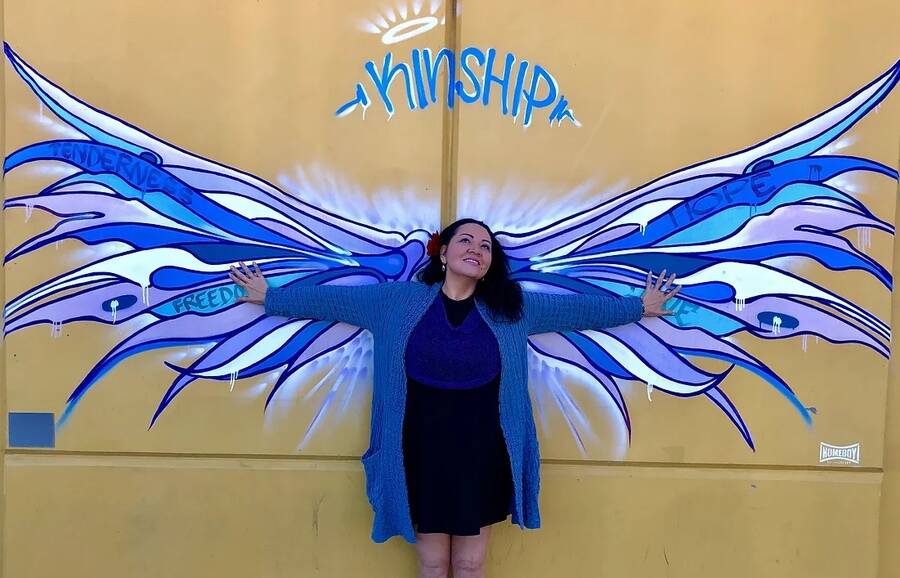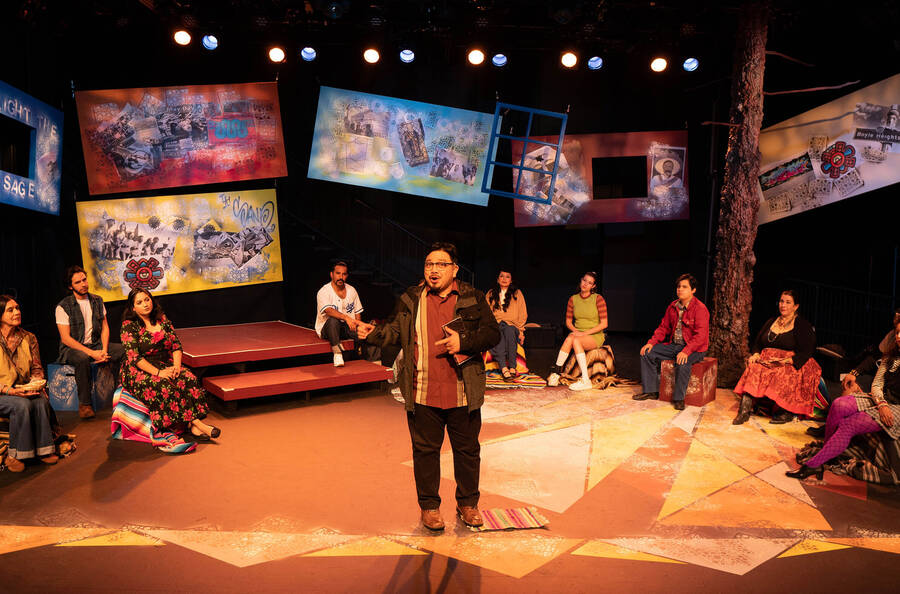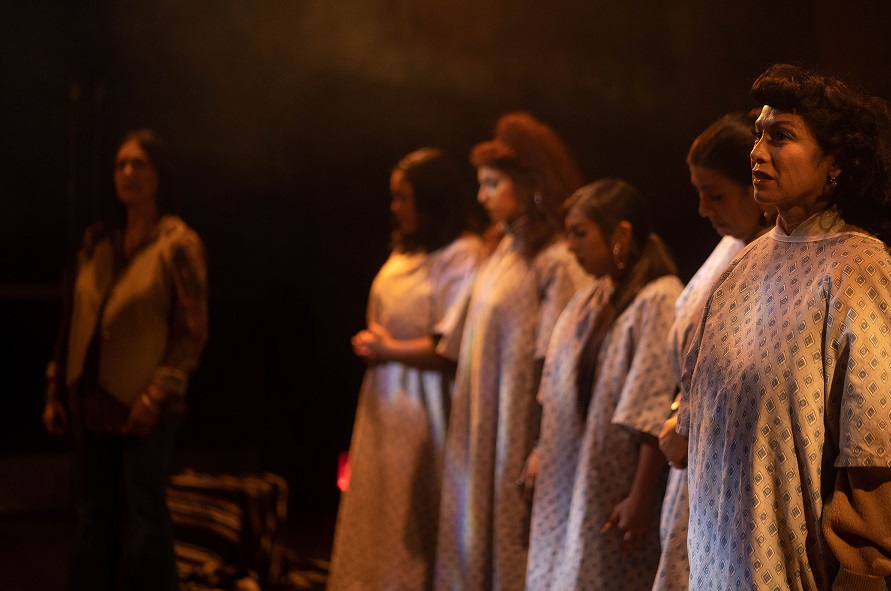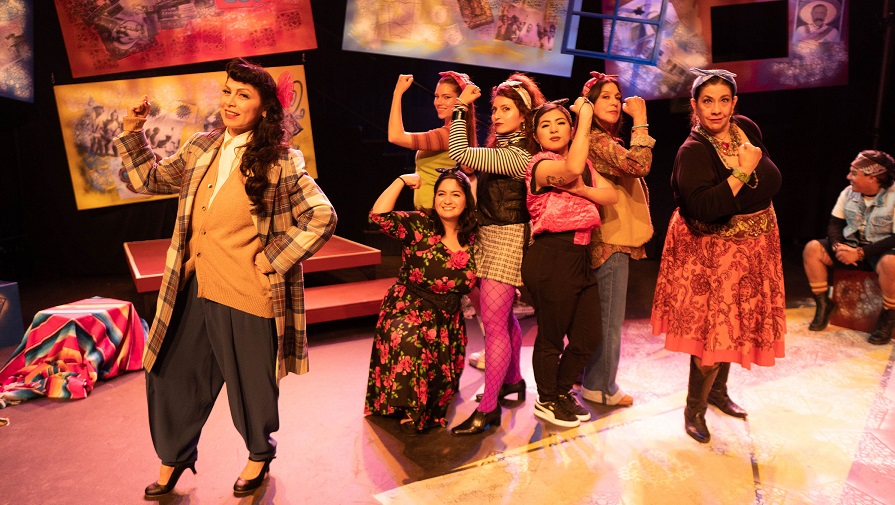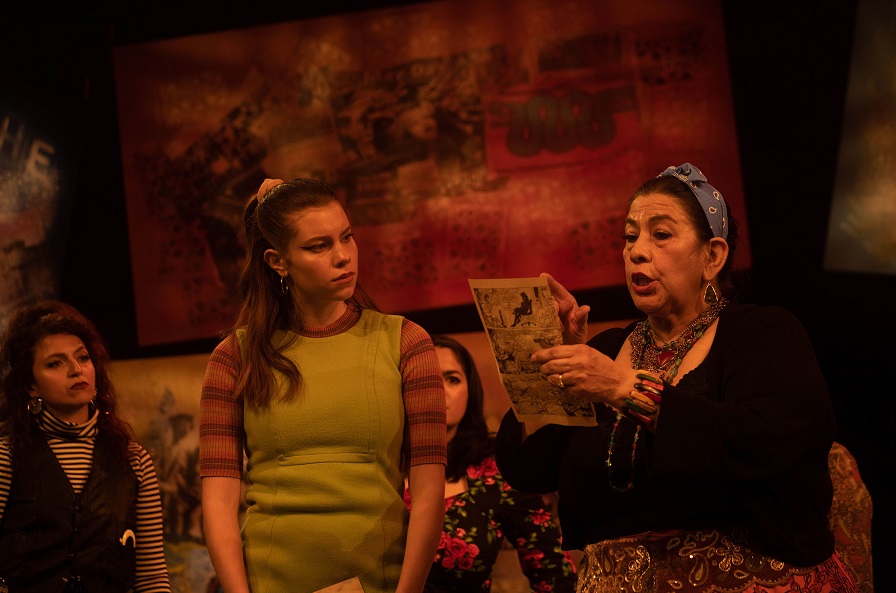Josefina López contains multitudes. The versatile writer-actor-producer, best known for the 1990 play Real Women Have Curves as well as the screenplay for the popular film version (which introduced America Ferrera and recently celebrated its 20th anniversary), came by TCG’s New York offices recently, ostensibly to talk about Remembering Boyle Heights: Part 2, a historical anthology show now running at Casa 0101, the theatre she founded in the East Los Angeles neighborhood of its title, through Dec. 18. The show, created by herself with director Corky Dominguez and an ensemble of young writer-performers, collects the stories of the neighborhood and its residents from post-WWII up through the early 2000s, from a celebration of Mariachi Square to the recovery of such lost stories as the forced sterilization of Mexican American women and the gender-bending style of pachucas (essentially, the female equivalent of the 1940s-era Zoot suit-wearing Chicanos), from the testimony of street vendors to the oral history of the East L.A. punk scene.
But our conversation also couldn’t help ranging widely, from her biography as an undocumented immigrant to her experiences writing for television (which included a long-ago stint on In Living Single and may soon include a spot in the writers’ room for The Madonnas of Echo Park), to the difficult mission she’s taken on: to bring fine arts and fine dining to her home community without gentrifying it. The occasion for her trip to NYC was a reading of a new musical adaptation of Real Women, with a book by Lisa Loomer, songs by Benjamin Velez and Joy Huerta, and direction by Sergio Trujillo, so we started out talking about that.
Our conversation has been edited for concision and clarity.
ROB WEINERT-KENDT: You’re in town for the reading of a musical of Real Women Have Curves, but you’re not writing the book. How have you been involved?
JOSEFINA LÓPEZ: I have been looking at drafts and giving notes to Lisa Loomer. Because, you know, I was undocumented. I have a very unique experience, and the show comes from my life. So there are a lot of beautiful things, but there are little things where I go: Okay, an undocumented person is always hiding, so they wouldn’t do something as frivolous as this—something that you think is cute and funny, and really works for a Broadway show, but an undocumented person would be like, “You don’t do that, because you’re scared.” Tiny notes like that.
I know you have a TV project in the works, but it’s been a long time since you worked in TV, right?
When I was 21, I worked on Living Single. It was very hard to be 21 and Latina. Basically everywhere I went, I was the only woman or the only Latina, and also the youngest person. So I kind of had to walk away from TV. It was an environment where my opinion was almost invisible, almost unheard. For me, theatre is sacred, because it’s where I go to heal. After that experience on TV shows, I just was like, I want to go do theatre, because that’s where you build community. That’s where you have catharsis. That’s where you have satisfaction as well; you see your plays produced. I’ve been working as a screenwriter for over 30 years, and I mean, thank God Real Women Have Curves got made as a movie and was so successful, but I’ve written over 20 screenplays and 10 TV pilots that have not seen the light of day, because they’re about women, they’re Latino, they’re too controversial or provocative, or not commercial enough, or whatever excuse.
One year, when I was 25, I had TV deals with three different networks in three different genres, and none of them got picked up. We were working with Norman Lear, who was championing the sitcom conversion of Real Women Have Curves, but even with Norman Lear, we couldn’t get a TV show on the air. I did 18-hour days for six months trying to write three TV pilots, and it just burned me out. Then I went back my barrio; I went back to live at home with my parents. It was a very humbling experience. And then I basically started doing theatre and poetry and performance.
But that was a return, right? You’d done theatre before.
I started doing theatre very early on; I went to the Los Angeles County High School for the Arts, so I’d been doing theatre since I was 15. I went to Shakespeare camp when I was 16 in Ashland, Ore., and when I graduated from the high school for the arts, I came to NYU to study playwriting. I didn’t like it; I didn’t fit in. It’s so wonderful how it’s all about inclusion and diversity now, but back then I was such a rare fish.
It sounds like you were ahead of your time.
I’m always ahead of my time. That’s my problem.
Writers’ rooms on TV have gotten much better, from what I understand.
Oh my God, I’m so jealous of all the young writers that are starting now. I feel like I had to face the slings and arrows—I tell people, I’m Wonder Woman, I walk into a room, the minority, the woman, the working-class person, and I’m basically taking all the bullets, and then I’m opening the door and saying, “Get in, get in!” That’s been my experience: I’m very outspoken, and I don’t get hired, but they hire the person behind me.
In Remembering Boyle Heights, the story of Laurie, who talks about being brought here by her parents and not realizing she was undocumented—that’s your story, isn’t it?
That is definitely my story. I’m basically a character, and so is Prof. George Sanchez, but in the play we call him Professor Fong. But it’s definitely my story. I’ve had all these identities. I’m Chicano, Mexican, Latina. I’m also Latinx. I’m also an Indigenous person. So I carry all these identities, and I know exactly what they all mean. I’m all of them, you know?
As an editor, I try to call people whatever they choose to be called—even if, in Florida, for instance, many folks call themselves Hispanic, though I think of that more as a linguistic category.
Well, the other reality is that Latino people who come from privilege honor the European, white side, and they tend to make sure you know they come from Spain, because they have all these other privileges, especially in Cuba and in New Mexico, where they say, “No, no, we really look white, and we’re Spanish, we never went through Mexico.” But Hispanic is a very offensive word to people who are activists and Indigenous people.
I do know that the folks at Bilingual Foundation of the Arts out in L.A. tend to embrace the term.
Well, they never produced my plays. They mostly do works by Latin American writers.
Similar to Repertorio Español in New York City.
Yes, because usually people that do theatre are privileged people, the bourgeoisie—fresas. But I’m an undocumented person, a working-class person who grew up in the hood, the barrio. It’s very rare that someone like me gets to open a theatre in their own community in English, with some Spanish.
I also know the folks from Latino Theater Company, and Diane Rodriguez, who started out in El Teatro Campesino. Some of them have privileged backgrounds, but they’ve also been part of that collective theatremaking tradition.
Yes, but the reality is that I couldn’t get produced in L.A., even by the Latino theatre companies, so I was forced start my own theatre company. The other thing is that these Latino theatre companies—and I’m not saying all of them, and I don’t want to name any specific one—basically want to do theatre for middle-class Latinos who can afford theatre tickets. So I basically said: You know what, I am a community theatre. I don’t think community theatre is a dirty word. I’m very proud of the community work that we do. We changed the narrative in Boyle Heights. The five o’clock news would only cover the drive-bys. When I was growing up, the only time Boyle Heights was mentioned was a drive-by here, drive-by there. So I wanted to say, “Come show the celebrations, come show the victories, come show our community—all the beautiful things that you don’t get to see that I get to see.” That’s what my work is about.
And that’s when you founded CASA 0101?
I got the lease in April 2000, but in 2002, we started producing Real Women Have Curves and consistently started doing shows year round. Then in 2011, we opened the big 99-seat theatre across the street.
I know Real Women has had many stage productions since the movie came out, but it was a play before it was a movie, right?
It started as a play that I wrote at the Intar Hispanic Playwrights Workshop back in 1988. I worked with Irene Fornés preparing a first draft, and then I workshopped it later with Teatro de la Esperanza in San Francisco. They did the world premiere in May of 1990, and even before the play opened, I got a call from Warner Bros., because there was an article in The Pink Pages in San Francisco, and they were asking me if the movie rights were available. It hadn’t even opened! I guess they were thinking, how the hell does a 21-year-old young woman who was undocumented and working in a sewing factory write a play about her life, and it’s about courage and dignity and the value of women? So they read the play and they were interested; it was optioned for a movie and I got to write the screenplay, and 11 years later, through a bunch of different producers and studios, it finally got made, with the help of producer George LaVoo, who was my co-writer on the screenplay.
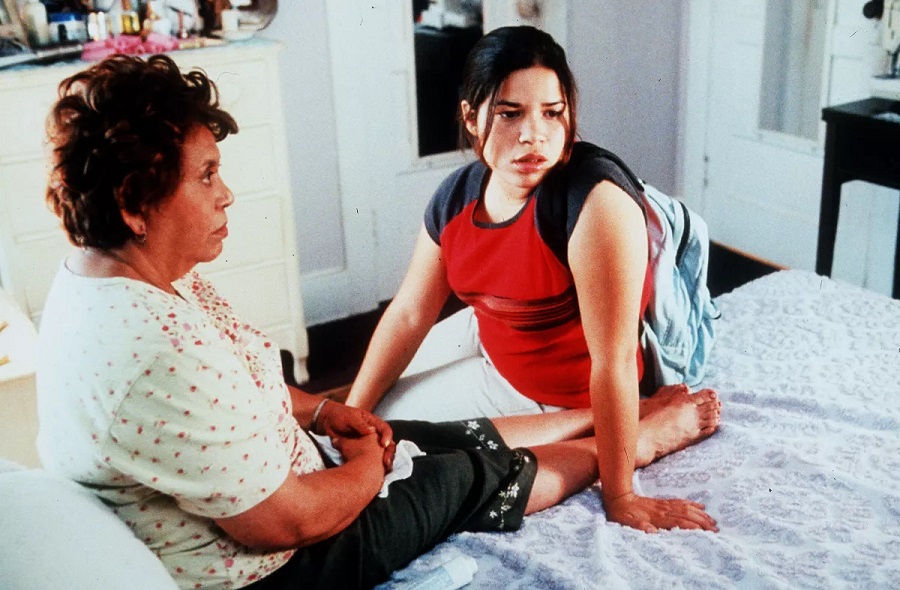
I don’t know the whole story of your undocumented status. Can you tell me about that?
So my parents brought me and my brother—I have seven siblings—to the U.S. I was 5 when I came, and I didn’t know I was undocumented until I was maybe 10 or 11. When my sister tried to go to college, that’s also when I found out, oh, wow, it’s really hard. I’m not gonna be able to go to college; I can’t get financial aid. I was very scared.
So you were what we now call a DREAMer, essentially?
I tell people I was a DREAMer before it was cool to be a DREAMer. They just called us wetbacks then.
But you have your citizenship now.
Yes. At 18 I qualified for the Simpson-Mazzoli amnesty bill and got my green card; I became a U.S. citizen in 1995. When I first got my green card, I was in the sewing factory. I said, “I want to celebrate this moment, because it sucks that this little card that has my name on it makes me a human being, that now I get some degree of respect.” When I was in the sewing factory, most of the women were applying, and my sister, who was the boss of the factory, was the last one to apply. My mother made this joke that, wouldn’t it be funny if ICE—it was called INS or La Migra back then—but what if they came and instead of taking the employees, like they usually do, they take the boss? We all started laughing. And I said: That’s the premise. That’s the plot for Real Women Have Curves.
The other thing is that we laughed a lot; we always told jokes. My mother would say the raunchiest things! It was the first time I had been in an environment full of women. I was very athletic, so I was always the only woman on boys’ teams. I was always around men; I was usually the captain. So to be in an environment for the women, where there was softness and vulnerability, I saw the value of women, the power of women working together.
The play and the movie are quite different, so what is the musical going to be like?
What’s beautiful is that because I have a play and a movie, the book of the musical now combines both things. And it’s contemporary, set in the present. Originally the producers wanted to keep it as close to the play as possible, but they realize now that there are a lot of beautiful emblems from the movie that they need to use. So it’s a combination of the two, with, of course, Lisa’s take on it. We now have all these amazing women, who, after Trump won, said, “If that bozo can be the president, anybody can—let’s go be leaders.” So it also celebrates all the progress that has happened for women’s rights—despite the abortion decision.
Well, I know Lisa has another play on that subject that is getting some new productions. So after NYU, you went to Columbia College in Chicago. Did you see much of the city’s famous theatre while you were there?
No; I was so broke. I could only ever go if I got free tickets. But I did get produced at Victory Gardens.

One common story about L.A. theatre is that it doesn’t get recognized at all. Mark Ruffalo did a lot of 99-seat theatre but didn’t get attention from L.A. casting directors and agents until he was in This Is Our Youth in New York.
Right, I have to make it in New York and then they’ll produce me in L.A., only five minutes from my house. I pointed this out to all the artistic directors in a public panel at Pasadena Playhouse. We were talking about diversity and inclusion, they were like, “There’s no prejudice in favor of the East Coast.” I said, “Bullshit. That’s why I started a theatre company, because you would never produce me.” Everybody applauded. I’m the person that will call people’s shit out, and then I’ll pay the price. But I’m happy to do that. I think that’s my role. I know that I can produce theatre; I can produce films. I can basically do anything myself, including give myself plenty of orgasms. I’m pretty independent. The reason I’m not afraid is, I can eat Top Ramen for the rest of my life; I can eat beans and rice, right? You don’t scare me, because I’ve never had privilege. I’m not afraid to lose anything. Maybe this is the role of the writer, to say: “Look, you don’t want to see it; I’ll show it to you.” People will attack me, it’s okay. You can’t take me down. I’ve had racism, sexism, every kind of ism thrown at me. Now it’s ageism. So I go: Just try taking me down. You cannot.
I read that you have a restaurant too, is that right?
Yes. I went to Cordon Bleu; I am a chef. My ex-husband is French American. We were against the Iraq war; we protested and then we moved to France. We were going to start a life in France, and I went to Cordon Bleu. Long story short, I realized that as much as it sucks to be a Mexican here, it’s even worse in France. I got mistaken for an Arab all the time, and I was treated even worse. I was like, you gotta leave your country to love it. So I wrote a novel and I got a degree from a French cooking school, and then we came back. And we said, let’s start a theatre, but do it professionally. And that’s when we decided to start Casa 0101. And my favorite restaurant, La Serenata de Garibaldi, which had this incredible French Mexican fusion—we found out that they closed down, went out of business. We didn’t want it to become a symbol of gentrification; that restaurant becoming a hipster brewery bar or whatever would be like the nail in the coffin for gentrification. We had been trying to open a French restaurant just down the street at another location.
The ridiculous thing is—you know, when they built Los Angeles, they basically built East L.A. to be the servants’ quarters, so there’s no parking, because people were too poor to have cars; they had the red trolley. So it was created in a way that this community could not thrive. In L.A. you cannot open a restaurant without parking. We couldn’t even open a theatre without parking; I had to go to the Boyle Heights Chamber to beg and cry and say, “Look, we’re trying to open a performing arts center; there are 87 gangs in this community but there’s no theatre, no cultural center. You know why there are 87 gangs? Because they don’t need permits for parking.” Boyle Heights was supposed to be the ghetto. It was created to be a ghetto. And so it’s been my attempt to bring theatre and fine dining, the beautiful experiences that rich people take for granted—I just want working-class Latinos to have this. When I lived in Paris, I was so amazed; even if you’re unemployed, struggling financially, you can still get vouchers to go see a play and go have a nice dinner. It’s considered a human right to be inspired, to get enriched. And I remember thinking, wouldn’t that be wonderful if people could come have dinner, go to the theatre, see something inspiring, and be so inspired that they want to keep the conversation going, and go back for drinks and dessert? And wouldn’t it be great if the actors had a place to go? That was my dream, to have a destination. Because everywhere else you can do that, except these communities.
I tell people that the reason I do theatre and the arts is because I want to remind people that we’re not just cheap labor—that we have a heart, that we have a soul, that we have dignity. That we are more than your “essential” workers; we are human beings with dreams. And so for me, theatre has been an opportunity to give voice to all this wounding pain and suffering, and to help people see themselves beyond just the Mexican who does your dirty work. God gave us gifts; we were endowed with all this beauty and grace, and I want to see that onstage. And I want our stories to inspire, because I tell people, look, in our community, you join a gang or you join the Christian church, right? To me the theatre is in between. We’re not telling you to join a gang; we’re not telling you to believe in Christ. We’re just telling you to love yourself.
Tell me a bit more about Remembering Boyle Heights.
We’re basically trying to tell as much of the history, and herstory, of Boyle Heights. The first part went until 1945, when the Jewish community started leaving, once the housing covenants were broken and people of color could move west of the L.A. River, and the first Latino Councilman was elected, Ed Roybal, and the coalition between the Jewish and the Mexican community; it tells all these amazing stories that celebrate Jewish, Japanese, Italian, all these cultures. The reason I did these pieces is because of gentrification; I don’t want my community to be all washed out; we have a history, and this is American history. We have to collect the stories and inspire people, rather than fighting hipsters and fighting people who are gentrifiers—people don’t really understand how gentrification works. It’s not about white people coming in; Latinos can gentrify too. It’s about people having an awareness that there’s already something here, and you can contribute to the canvas, put your color in there, but don’t whitewash it and make it disappear, because then you’re erasing all this beautiful American history, Chicano history and Mexican American history. My history. Boyle Heights is my home. I want people to know that I’ve been there.
Is Boyle Heights still facing gentrification?
It’s been gentrifying, but it is going slowly. The good thing is that everyone knows that if they come in without respecting what is there, they will get a fight. What’s interesting is that Boyle Heights is the only community in the world that has fought back using arts and creativity. And Prof. George Sanchez goes around to different parts of the world to lecture on how our community has fought back against the art world. The corporation’s are getting more creative in the way they come in; one of the ways they’re doing it is through murals doing it. It’s art but it’s really a commercial; they hire the Chicano artists who need the money, who are happy to do it. So it’s kind of shady. The other thing that’s happening is a lot more policing, and they’re making the streets friendlier, but they’re taking away parking, which already is very hard. I’ve actually thought about whether I want to stay in Boyle Heights; I’ve thought about moving to Queens and starting a Latino theatre company there.
I live in Queens, and you would be most welcome there.
Thank you. This is therapy for me.
Rob Weinert-Kendt (he/him) is the editor-in-chief of American Theatre.
Creative credits for production photos: Remembering Boyle Heights at Casa 0101, written by Josefina Lopez, Corky Dominguez & The Remembering Boyle Heights Ensemble, directed by Corky Dominguez, executive produced by Emmanuel Deleage, stage manager: Daniel Corona, technical director: Max Brother, assistant director: Rosa Navarrete, lighting designer: Kevin Vasquez, sound designer: Angelica Ornelas, set designer: Cesar Retana-Holguín; costume designer: Abel Alvarado, prop master/ASM: Doreen Sanchez, graphic designer: Itzel Ocampo;Real Women Have Curvesat Dallas Theatre Center, directed Christie Vela, with scenic design by Arnulfo Maldonado, costume design by Daniella Nieves, lighting design by Amanda West, sound design by John M. Flores, and hair and make-up design by Nicole Alvarez.Real Women Have Curves at Dallas Theatre Center, directed Christie Vela, with scenic design by Arnulfo Maldonado, costume design by Daniella Nieves, lighting design by Amanda West, sound design by John M. Flores, and hair and make-up design by Nicole Alvarez.

